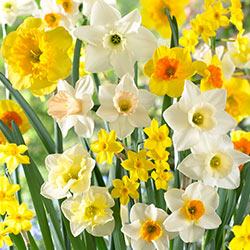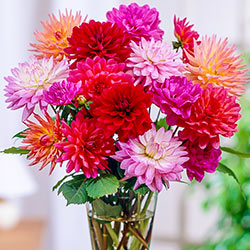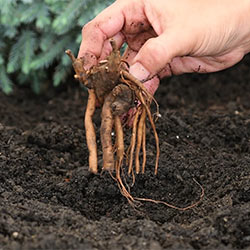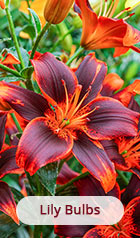
How to Plant Bulbs: A Guide to Planting Flower Bulbs
Flower bulbs are among the easiest ways to get started with gardening: plant them, allow them to sprout, and enjoy their spring and summertime beauty. Many gardeners use fall bulb planting to get excited about the following spring-after all, who doesn't need something to look forward to during the cold winter months? Luckily, flower bulbs are quite easy to plant and care for. Whether you're looking for fall-planted bulbs to bloom in spring or spring-planted bulbs to bloom in summer, it just takes a tiny bit of preparation to bring bundles of floral delight to your yard!
What Are Flower Bulbs?
So, first off-what is a
flower bulb? Flower bulbs are nature's pre-packaged flowers. A bulb is an underground storage unit, each containing a short stem and fleshy leaves. The flower bulb stores energy during the dormant period of the plant's life, and also contains the materials necessary to get the plant growing. During the growing season, the plant stem pushes upward, out of the bulb, to sprout leaves and beautiful flowers.
Types of Flower Bulbs
When we talk about bulbous plants, we're talking about any kind of plant that primarily grows from a bulb, instead of from a root or by reseeding itself. Onions and garlic are bulbs, as well as many kinds of ornamentals!
So, what type of flower is grown from a bulb? Think about many of your springtime favorites-
tulips, daffodils, crocus, hyacinth, and allium. When you consider summer-flowering bulbs, like dahlia and
calla lilies, you'll note that they share some of the thick, fleshy leaves and upright growth habit as spring bulbs.
Bulbs to Plant in the Fall

Many of our favorite springtime flowers, like tulips, daffodils,
hyacinths, snowdrops,
crocuses,
allium, grape hyacinth, fritillaria and Asiatic or Oriental
lilies, are planted as bulbs in the fall. These bulbs are sometimes called hardy bulbs because they spend winter in the ground. Hardy bulbs require a cold period, composed of several weeks of cold temperatures, before breaking their dormancy and sprouting.
Bulbs to Plant in the Spring

Some ornamental bulbs are planted in the spring, for summer and fall flowering. Some of these bulbs, like
dahlias and calla lilies, grow in more of a tuberous style. Instead of the well-known onion-shaped form, these bulbs will look like potatoes -- and they sprout from eyes.
Spring-planted bulbs are sometimes referred to as "tender bulbs." They'll bloom in the spring or summer after you've planted them, and some, like dahlias, will bloom right through fall. Tender bulbs don't require a cold period to bloom and should be planted after the weather warms in spring. Some flower tubers are hardy through the winter, and some require lifting.
Spring-planted bulbs include Dahlias, peonies,
gladiolus,
begonias,
caladiums, cannas, calla lilies, elephant ears, and autumn crocuses. Some types of bulb-grown
irises are also spring-planted bulbs.
When to Plant Bulbs
Some bulbs are planted in spring, and some in fall, depending upon their type and bloom time. So, what's the best time to plant bulbs?
When to Plant Fall-Planted Bulbs
The correct date for planting fall bulbs will depend upon your region, so check both your bulbs and your growing zone to find out when to plant.
Here are a few general rules:
- Don't plant your fall bulbs too early, as early planting may cause the bulbs to sprout in still-warm weather.
- Nighttime temperatures should consistently remain below 50 degrees before you plant your bulbs.
- In most places, you can plant bulbs right around the first frost date, before the ground freezes. You can plant as long as the ground is workable!
Keep in mind that the planting process looks a bit different for warm-weather regions, like zones 8 through 11. If your region never reaches freezing, your bulbs will not experience cold enough temperatures in the ground to bloom. That's okay-you can pre-chill your bulbs in a refrigerator! Just place the bulbs in the fridge, storing them away from fruits and vegetables. Keep them there for ten to fifteen weeks, then plant them in the ground at the coolest part of the year.
We aim to ship our bulbs at just the right time for planting. If you aren't able to plant when they arrive, or if your bulbs arrive during the still-hot months, store your bulbs in a cool and dry place until you're ready to plant.
When to Plant Spring-Planted Bulbs
When should you plant your spring-planted bulbs? The answer can depend upon both the type of flower and your location, so check your zone and any instructions associated with your bulbs. However, most spring-planted bulbs should go into the ground after the last frost date. Here are some things to keep in mind:
- Wait until the soil is warm, and make sure the last frost date has passed before planting your spring bulbs. If you plant too early, your bulbs might sprout and experience a bit of frostbite.
- If you live in a cold region, you can start your bulbs indoors about six to eight weeks before your last frost date. Starting indoors is surprisingly easy to do! Use a container of potting mix, and plant your bulbs as deep as you would plant them outside. Then, place the container near a sunny window. After the last frost date, you can plant them in the ground in the same way you'd plant other potted plants.
- You'll need to water your spring-planted bulbs right away! Unlike fall bulbs, spring-planted bulbs will come out of dormancy soon after planting. So, go ahead and water them weekly once you've set them in the ground.
Just like with our fall bulbs, Michigan Bulb sends tubers and bulbs at the right time for planting. If you aren't able to plant your bulbs right away, just store them in a cool and dry location until you are ready to plant.
How to Plant Bulbs: Step-by-Step Instructions
There are two basic methods for planting
bulbs-some gardeners dig individual holes for each bulb, and some use a trowel to dig a trench row for several bulbs. Regardless, planting bulbs is an easy task! Let's get started:
- Loosen the soil to a depth of 6-8" and add some bulb fertilizer. Work the soil well, so that your plants will have nice, loose soil in which to establish roots.
- Figure out where you want to plant your bulbs, making sure to check spacing requirements.
- Place your bulbs. Most bulbs have a visible growing point, which should face upward. As a general rule, bulbs should be planted at a depth 2-3 times the height of the bulb.
- Cover each bulb, backfilling the hole to the same level as the soil. Lightly compress the soil, but don't pack it down.
- Water your bulbs in well! Watering can stimulate root growth, and it will help get rid of any air bubbles around the bulb.
Congrats! That took just five steps, and your bulbs are planted. If you live in a cold zone and are planting in fall, you might want to mulch over your bulb plantings before the winter cold sets in. Then, you're ready to wait and watch for a colorful display in the growing season.
After Care for Flower Bulbs
Bulbs are among the easiest plants to care for, so post-planting care is very simple. They don't require maintenance between growing seasons, and they come back year after year. Here are a few tips for making sure your flowers from bulbs are bright and beautiful.
Caring for Spring-Planted Bulbs
Bulbs that you plant in spring will start growing almost right away. You're planting them at the beginning of their growing season! Start watering the bulbs weekly after planting them, and use a water-soluble fertilizer once when they begin to sprout, and then again when they begin to bloom.
After flowering, your spring and summer bulbs can be deadheaded. Cut the flower off, but don't remove the foliage-bulbs use their leaves to collect energy and store it for the following season. Once the leaves have gone brown and wilted, you can cut them to ground level.
Caring for Fall Bulbs
After planting your bulbs in the fall, you have a fairly easy task until spring-simply leave them alone! You won't begin watering until the bulbs sprout. Once they do, apply a water-soluble fertilizer, and water your bulbs each week-and maybe more often during a dry spell.
After flowering, you can pick spent flowers off of the bulbs, but leave the foliage alone so that your bulbs can gather energy to store over winter. Once the foliage begins to die back, you can cut it to ground level.
Lifting and Storing Bulbs
If you experience cold winters, some summer bulbs may need to be lifted and stored over winter, to keep them from being damaged by frost. If you experience warm winters, some fall bulbs may need to be lifted and chilled, to give them the cold period you need to kickstart your planting. Luckily, lifting and storing bulbs is easy!
Use a spade to lift bulbs out of the ground, and dust off any excess soil. You'll also want to trim off their dying leaves: dirt or leafy matter can collect fungus and pests. Allow them to rest in a cool, dry location for several days. A sheet of paper or cardboard is a great curing surface for bulbs. When the bulbs are cured, they will be dry to the touch.
Once the flower bulbs are dry, gently place them in a box with a dry material like peat moss or packing peanuts, or use layers of brown paper or paper bags to separate them. Store your bulbs with the pointed end of the bulb facing up and the roots facing down, and leave some space between the bulbs.
Your stored bulbs will go back into the ground after all threat of frost has passed. Fall-planted bulbs will need to be chilled in order to begin growing, so place them in a refrigerator - away from any fruit or vegetables, and not at freezing temperatures - for about six to eight weeks before planting.
Other Hints, Tips & Tricks for Bulbs
Now you have the basics of growing flower bulbs! Next comes the fun part-shopping for bulbs and designing the garden of your dreams.
Design Ideas
With so many ways to make a bulb garden, where to begin? Here are some of our favorite tips for making your bulb garden look amazing!
- Consider bloom times. When selecting bulbs, choose plants that bloom at different times, so that you'll always have something blooming in the garden. Choose a variety of early bloomers, mid-season, and late-blooming spring bulbs. Bonus points if you consider the bloom times of your bulbs when choosing summer flowers and perennials!
- Look for a variety of heights. In beds and borders, tall flowers like irises and daffodils are stunning behind shorter species like hyacinths, and very low-growers such as crocus or grape hyacinth.
- Limit yourself to a few favorite colors to create a cohesive feel, or create a garden of many hues of a single color. Or, throw the rules out the window and create a rainbow effect! Consider pre-planned bulb collections for a designer touch.
- Don't forget about the possibilities available with planters. Many bulbs can be grown in containers, and some can be forced indoors or started indoors.
- Layer your flower bulbs. Small bulbs can be planted over large ones, using a method some gardeners call "lasagna planting." Smaller bulbs are typically shorter flowers, so you can achieve a "double-decker" effect with two plantings in the same location.
Remember-your design is yours alone, and there's no way to fail with flower bulbs arrangement.
Buying Flower Bulbs
Whether shopping for flower bulbs online or in the store, keep an eye out for quality-not just the lowest price.
- Map your garden before you shop. Make sure you'll have space for all the bulbs you purchase, and that you're shopping for flowers that can handle the sun and soil specifications in your landscape
- Look for bulk discounts. Some bulbs are available in larger quantities at a lower price. Bulk buying can be perfect if you want to naturalize.
- Bulbs should be dry and solid, not moist or squishy. Texture can be a telltale sign of rot or decay.
- Don't sleep on mixed bags. Mixtures of bulbs sold as a set can be a great way to get into gardening.
Luckily, many of our favorite varieties are available at a low cost, making bulb gardening one of the least expensive ways to fill in the landscape.
Bulbs are some of our favorite flowers-that's why they're right in our name! Bulbs are easy to plant, carefree to grow, and a lot of fun, especially for gardeners just starting out. There's just something amazing about seeing a tiny bulb grow into a big, beautiful flower. Be sure to check out our bulbs, as well as our
shrubs, perennials, and more.
Have another question? Return to the Customer Service Help page or send an e-mail directly to Customer Service
























